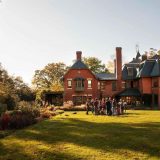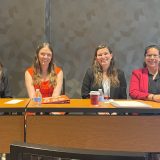
Wilkinson College’s Ghost Hunt
October 29, 2021
Just in time for Halloween, Sociology Professor and Department Chair Chris Bader, who specializes in studies of fear and the paranormal, led fifteen Wilkinson College students, faculty, and staff on a tour of the Dr. Willella Howe-Waffle House, a “haunted” residence of one of Orange County’s first female physicians, who lived and worked there from 1889 until she died in 1924.
Guests at the house report hearing voices and inexplicable noises, witnessing orbs of light travel across dark rooms, and even seeing the spirit of Dr. Howe-Waffle herself.
Ten lucky winners, who entered a raffle by attending the Sociology Department Mixer on October 6th, chose to RSVP for this chilling excursion. Dr. Bader hoped this event would “drum up some excitement” around the Sociology department and promote a sense of community between students and faculty.
Upon arriving at the Howe-Waffle House, participants were split into one of two groups. The first group was given a general overview of the house’s history and the paranormal activity reported on site. The second group was not informed of any supernatural phenomena before starting their ghost hunt on the second floor. Dr. Bader referred to this choice as a sort of experiment and was curious to see how different perspectives and prior knowledge affect the results of the ghost hunt.
Ghost hunters in both groups used audio recorders to detect Electronic Voice Phenomena (EVP), soundbites attributed to paranormal activity. In some instances, ghost hunters utilized a ‘Spirit Box’ – a device that scans numerous radio stations at once. The intention is to ask questions directed toward spirits in the room. Spirits may then respond by sending messages through the box. Alongside the informed group, paranormal investigator Ramiro Ramirez asked the room how many spirits were in the building, to which the Spirit Box responded: “treinta” (the Spanish word for thirty). When asked to identify one of the guests present that night, numerous students and faculty insisted that they heard the radio say “Chris.”
Dr. Nancy Rios-Contreras of Sociology recalled her experience using dowsing rods, pieces of equipment used to locate groundwater sources in the past. Today, ghost hunters use dowsing rods during paranormal investigations by asking spirits to interact with the rods, spinning them in one direction or another. During her investigation in the upstairs children’s room, members of her group asked the spirits to switch the direction of the spinning rods, and the rods responded almost immediately. This occurred twice, to Dr. Rios-Contreras’ surprise.
“I went into the ghost hunt with an open mind and witnessed firsthand an unexplainable occurrence. The rods began spinning in both directions on command. I’m glad to have shared this eerie experience with the Sociology department.”
Another popular attraction was Dr. Howe-Waffle’s carriage house. Today, it is used as storage for the museum, but she would often house patients there on the second floor. The home managers reassured the guests that night that spirits in the house were not evil and felt more ‘enchanted’ than ‘haunted.’ However, the second floor of the carriage house is reported to convey a heavy, sinister feeling to many who enter it. One by one, Chapman guests took turns sitting in the dark carriage house alone, for two minutes at a time, to see if anyone would catch some sign of paranormal activity.
The Sociology Department is already looking forward to the next Halloween season, with plans to elevate the paranormal experience by visiting another haunted site in Orange County.



